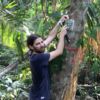Acoustic sensors enable efficient and non-invasive monitoring of a wide range of species, including many that are difficult to monitor in other ways. Although they were initially limited in application scope largely due to cost and hardware constraints, the development of low-cost, open-source models like the Audiomoth in recent years has increased access immensely and opened up new avenues of research. For example, some teams are using them to identify illicit human activities through the detection of associated sounds, like gunshots, vehicles, or chainsaws (e.g. OpenEars).
With this relatively novel dimension of wildlife monitoring rapidly advancing in both marine and terrestrial systems, it is crucial that we identify and share information about the utility and constraints of these sensors to inform efforts. A recent study identified advancements in hardware and machine learning applications, as well as early development of acoustic biodiversity indicators, as factors facilitating progress in the field. In terms of limitations, the authors highlight insufficient reference sound libraries, a lack of open-source audio processing tools, and a need for standardization of survey and analysis protocols. They also stress the importance of collaboration in moving forward, which is precisely what this group will aim to facilitate.
If you're new to acoustic monitoring and want to get up to speed on the basics, check out these beginner's resources and conversations from across the WILDLABS platform:
Three Resources for Beginners:
- Listening to Nature: The Emerging Field of Bioacoustics, Adam Welz
- Ecoacoustics and Biodiversity Monitoring, RSEC Journal
- Monitoring Ecosystems through Sound: The Present and Future of Passive Acoustics, Ella Browning and Rory Gibb
Three Forum Threads for Beginners:
- AudioMoth user guide | Tessa Rhinehart
- Audiomoth and Natterjack Monitoring (UK) | Stuart Newson
- Help with analysing bat recordings from Audiomoth | Carlos Abrahams
Three Tutorials for Beginners:
- "How do I perform automated recordings of bird assemblages?" | Carlos Abrahams, Tech Tutors
- "How do I scale up acoustic surveys with Audiomoths and automated processing?" | Tessa Rhinehart, Tech Tutors
- Acoustic Monitoring | David Watson, Ruby Lee, Andy Hill, and Dimitri Ponirakis, Virtual Meetups
Want to know more about acoustic monitoring and learn from experts in the WILDLABS community? Jump into the discussion in our Acoustic Monitoring group!
Header image: Carly Batist
Careers
The Institute for Bird Populations (IBP) seeks a California-based acoustic monitoring specialist to collect, manage, and process avian acoustic data from multiple research and conservation projects across California...
26 October 2023
With the rising threats to biodiversity such as wildlife crime, climate change and human-wildlife conflict today, wildlife monitoring technologies have become vital to study movement ecology, behaviour patterns, changes...
25 October 2023
To study song evolution in time and space, we will use individual acoustic monitoring (IAM) - a non-invasive method that allows the identification of individuals based solely on their vocalisations. In this project, we...
20 October 2023
The Marie Skłodowska-Curie PhD Fellowship in Bioacoustic AI for wildlife protection. The PhD position advertised here will be based at the KU Leuven Electrical Engineering Department (ESAT), under the supervision of...
20 October 2023
FLOATERS: Using individually distinct vocalizations to estimate breeding and non-breeding population of a species. Apply for the fully funded PhD position now!
20 October 2023
The Kitzes Lab at the University of Pittsburgh (http://kitzeslab.org) is seeking applications for a Postdoctoral Scholar, Research Assistant, and Graduate Student to work in the areas of bioacoustics, quantitative...
28 September 2023
Careers
Island Conservation's Innovation Team is dedicated to developing innovative, data-driven tools to increase the scale, scope, and pace of island restorations around the world. As the Conservation Innovation Manager, you...
27 September 2023
If only there was a place where these users, manufacturers, and supporters of conservation technology could connect with one another. There is. It is called WILDLABS.
22 September 2023
The new white paper from Rainforest Connection (RFCx) explores the power of ecoacoustics and AI to monitor biodiversity and track progress towards GBF targets using case studies from around the world.
20 September 2023
Article
Five #tech4wildlife people, projects and updates that caught our attention this month. An AI supported bear early warning system, a project that's connecting indigenous communities with high speed internet, exploring...
12 September 2023
The Smithsonian Institution seeks a field- and data-oriented biologist to support marine animal telemetry research and to assist with activities of the Atlantic Cooperative Telemetry (ACT) Network.
24 August 2023
Apply to work on a wonderful team translating acoustic monitoring data into conservation & ecological insights!
11 August 2023
April 2024
June 2024
July 2024
event
April 2024
event
March 2024
event
WILDLABS AWARDS 2024 - TimeLord: A low-cost, low-power and low-difficulty timer board to control battery-powered devices
5 April 2024 3:29pm
16 April 2024 9:35am
Reminds me that we should look at both terrestrial and marine applications when we get stuck in to the demo builds to make sure we cover use cases
16 April 2024 10:22am
'Most importantly, we have to make it play a MIDI version of the DoctorWho theme song when you arm the device. That has to be the #1 feature if you ask me!'
Seconded!
Drop-deployed HydroMoth
2 April 2024 10:20am
5 April 2024 2:04pm
Hi Sol! This seems like an awesome project! I have a few questions in response: Where were you thinking of deploying this payload and for how long?
Regarding hydromoth recorders, there have been several concerns that have popped up in my work with deploying the them at this depth because it's a contact type hydrophone which means it utilizes the case to transmit the sound vibrations of the marine soundscape to the microphone unlike the piezo element based hydrophones.
- At 30-60m you will likely have the case leak after an extended period of time if not immediately. The O-ring will deform at this depth, especially around the hinge of the housing. The square prism shape is not ideal for deep deployments you describe.
- After that depth and really starting at about 50m, a major concern is synthetic implosion from the small air pocket of the hydromoth not having a pressure release valve and lithium ion batteries getting exposed to salt water. This type of reaction would cause your other instruments to probably break or fail as well.
- You are unlikely to get a signal with a reinforced enclosure. The signal is generated via the material and geometry of the housing. The plastic will probably deform and mess with your frequency response and sound to noise ratio. If you place it against metal, it will dampen the sound quite a lot. We tried to do this, but the sensitivity is quite low with a large amount of self noise.
A side not: for biodiversity assessments, the hydromoth is not characterized and is highly directional, so you wouldn't be able to compare sites through your standard aocustic indices like ACI and SPL.
That said if you are deploying for a short time, a hydrophone like an Aquarian H1a attached through a penetrator of a blue robotics housing that contains a field recorder like a zoom recorder may be optimal for half a day and be relatively cheaper than some of the other options. You could also add another battery pack in parrallel for a longer duration.
15 April 2024 6:53am
Hi Matthew,
Thanks for your advice, this is really helpful!
I'm planning to use it in a seagrass meadow survey for a series of ~20 drops/sites to around 30 m, recording for around 10 minutes each time, in Cornwall, UK.
At this stage I reckon we won't exceed 30 m, but based on your advice, I think this sounds like not the best setup for the surveys we want to try.
We will try the Aquarian H1a, attached to the Zoom H1e unit, through a PVC case. This is what Aquarian recommended to me when I contacted them too.
Thanks for the advice, to be honest the software component is what I was most interested in when it came to the AudioMoth- is there any other open source software you would recommend for this?
Best wishes,
Sol
WILDLABS AWARDS 2024 - BumbleBuzz: automatic recognition of bumblebee species and behaviour from their buzzing sounds
12 April 2024 8:37am
12 April 2024 8:41pm
Super great to see that there will be more work on insect ecoacoustics! So prevalent in practically every soundscape, but so often over-looked. Can't wait to follow this project as it develops!
WILDLABS AWARDS 2024 - Developing AudioMoth for the detection of infrasonic elephant rumbles
11 April 2024 7:35am
11 April 2024 4:05pm
Awesome project!!
Wildlife Drones will be at the 21st Australasian Bat Society Conference
9 April 2024 6:03am
WILDLABS AWARDS 2024 - Fostering bat conservation and citizen science in Zimbabwe: Establishing bat groups and training individuals to use bat detectors
4 April 2024 12:12pm
4 April 2024 7:44pm
Awesome project!!
My own curiosity here - how many different bat species are there in Zimbabwe?
8 April 2024 9:29am
Thank you Carly!
We have over 60 bats recorded in Zimbabwe
Thoughts on RooBadge?
2 April 2024 2:55pm
4 April 2024 5:25am
Hi @alexrood , I would normally be quite sceptical, as there's been quite a lot of work over here on what's called the 'shuRoo' (because of course that's what it would be called in Australia), and it doesn't seem to have as much of a beneficial effect as one might hope (e.g. https://meridian.allenpress.com/australian-zoologist/article-abstract/42/3/690/472529/Roo-the-day-evaluating-the-ShuRoo-for-prevention). However, given that it involves two researchers with a wealth of knowledge about macropods and deterrents (and the very same authors of the ShuRoo experimental trial linked to above), I am much, much more optimisitic! Shall be watching (or listening to?) this one with great interest and thanks for sharing!
Cheers,
Rob
5 April 2024 12:31pm
Sound deterrents to prevent collisions with Kangaroos in Australia have been sold for many years. None have been shown to work. Whether the Volkswagen device will be any better waits to be seen. Collision data will have to be collected for a while to see if the VW device has any effect on collision rate.
8 April 2024 12:49am
That is an interesting concept, and it would be great if something out there worked. In the meantime, I will try not to drive at dusk 🦘
At one point, I knew the "sonic" animal guards were the most stolen components of cars. You head in, get groceries, and come out, and they are gone. They weren't on the car long enough for me to confirm that would work
WILDLABS AWARDS 2024 - Underwater Passive Acoustic Monitoring (UPAM) for threatened Andean water frogs
30 March 2024 3:54pm
2 April 2024 2:35pm
Thanks @carlybatist for your suggestions! In deed we are looking for open code/free access alternatives for automated species recognition
5 April 2024 12:13pm
Congratulations, very exciting! Keep us updated!
7 April 2024 6:09pm
This is so cool @Mauricio_Akmentins - congrats and look forward to seeing your project evolve!
WILDLABS AWARDS 2024 - FinDrop: Accessible Acoustic Monitoring for Mesophotic Marine Environments
5 April 2024 10:22pm
7 April 2024 6:07pm
Congrats @MattyD797 and team!!! We do a lot of work in the underwater bioacoustic realm and your tool certainly seems like it would be a great instrumental addition to the community. Look forward to learning more about your project!
Liz
Underwater advertisement call of the threatened Telmatobius rubigo (Anura: Telmatobiidae
6 April 2024 9:56pm
Bioacoustic device security in urban parks
8 March 2024 2:49pm
24 March 2024 4:53am
Yes, I agree with Panji......make sure you have notes of where you put them and remember that photos of trees without leaves look completely different 6 months later......not that I would ever make that mistake.........well not again......especially after spending 2 days trying to find 3 ARU's.
24 March 2024 9:38pm
We suggest and use Python Locks for urban areas here in Australia. Can also screw the Mini 2 to a tree or phone post with the python lock.
5 April 2024 12:55pm
We've deployed passive acoustic monitors in various urban environments without any issues of theft, even in locations where camera traps and other technology has been historically taken or vandalised. I think acoustic sensors generally look less valuable than other technology, and I would recommend removing or covering any stickers or labels on devices that would otherwise make them more appealing! Placing them in hedgerows or on trees with some (but not too much!) foliage will help keep them well hidden too.
Not so silent spectators: How spectator vessels at international sailing regattas alter marine soundscapes
3 April 2024 4:50pm
Check out how water-based sporting events are impacting underwater noise pollution for marine life.
Seventh International Conference on the Effects of Noise on Aquatic Life
3 April 2024 4:34pm
Postdoctoral Research Associate in Ecoacoustics
2 April 2024 2:49pm
Think Wildlife Podcast | The Role of Bioacoustics in Conservation with Bourhan Yassin, Founder of Rainforest Connection
28 March 2024 11:27pm
Hi,
I am Anish and I'm new to this platform! I host the Think Wildlife Podcast and wanted to share a recent episode with Bourhan Yassini. We talk in-depth about the role of AI and bioacoustics in conservation. Tune in to listen more!
AI for Conservation!
4 March 2024 8:51pm
22 March 2024 12:29pm
Welcome, Have you considered participating in any of the AI for Good challenges. I find it is good way to build a nice portfolio of work. Also contributing to existing open source ML projects such as megadetector or to upstream libraries such as PyTorch is good way to getting hired.
22 March 2024 5:57pm
Thank you for the tip! I'll definitely consider contributing to open source projects and taking part in challenges :)
25 March 2024 5:22am
We could always use more contributors in open source projects. In most open source companies Red Hat, Anaconda, Red Hat and Mozilla, people often ended up getting hired largely due to their contributions on open source projects. These contributions were both technical such as writing computer code and non-technical such as writing documentation and translating tools in their local language.
Recording Orthoptera Sounds: International Workshop (Italy)
22 March 2024 9:25pm
How does behavior influence the use of technology for animal detection ?
22 March 2024 7:49pm
Leveraging Actuarial Skills for Conservation Impact
15 March 2024 12:31pm
19 March 2024 6:35pm
Thank you for your response Akiba. I will have a look. 👏🏻
19 March 2024 7:52pm
I would look into the TNFD (Taskforce on Nature-Related Disclosures), Finance for Biodiversity, Accounting for Nature, etc. which are all focusing on how to incorporate nature risk into corporate reporting and sustainability frameworks!
20 March 2024 3:48pm
Thank you Carly, I will definitely take a look.
Unveiling the Cicada Symphony: Seeking Support for Bioacoustics Research
18 March 2024 12:41am
18 March 2024 3:25pm
Ah okay. I found it with google reverse image search:
I thought it would be huge, but it's little. Unbelievable what these tiny things can do for the price. Looks like the battery life will far exceed the capacity of the SD card in it (64GB).
19 March 2024 7:53pm
If you're interested in a free, no-code ecoacoustic analysis platform for your data, check out Arbimon!
BirdWeather | PUC
27 October 2023 7:45pm
2 November 2023 9:20pm
I love the live-stream pin feature!
14 March 2024 10:29pm
Hi Tim, I just discovered your great little device and about to use it for the first time this weekend. Would love to be directly in touch since we are testing it out as an option to recommend to our clients :) Love that it includes Australian birds! Cheers Debbie
16 March 2024 10:47pm
Hi @timbirdweather I've now got them up and running and winding how I can provide feedback on species ID to improve the accuracy over time. It would be really powerful to have a confirmation capability when looking at the soundscape options to confirm which of the potential species it actually is or confirm it is neither to help develop the algorithms.
Also, is it possible to connect the PUC to a mobile hotspot to gather data for device that isn't close to wifi? And have it so that it can detect either wifi or hotspot when in range? Thanks!
The Freshwater Sounds Archive
15 March 2024 10:32am
Introducing The Freshwater Sounds Archive, a global database of sounds produced by freshwater species.
Submit your species-specific or unidentified sounds to the archive now and receive recognition for your contribution in a forthcoming data paper as a co-author!
Senior Post-doctoral Researcher/Senior Research Associate Opportunity: Movement ecology of Greenland halibut
13 March 2024 2:00pm
Audiomoth Energy consuption estimates
4 March 2024 12:25pm
9 March 2024 6:13am
Agree with the differences between microSD cards. I tested Sandisk Ultra, Samsung EVOplus, and some no-name cards I found myself in possession of. Unfortunately I did not have a logging device, but I watched what was happening on my multimeter. The µMoth with an Ultra was peaking at over double the current flow of the EVOplus. The no-name card was peaking at about the same as the EVOplus but had a near constant background drain that was not obvious with the other cards.
Apparently, cards of different sizes also use different amounts of power:
It would be great if someone with a data-logging multimeter could conduct a search to find the most power miserly cards out there, but it would be a constant search as card specifications are changing all the time. The Samsung EVOplus cards are no longer available, but I have no idea if Samsung has redesigned their cards or just rebranded them. Often manufacturers are going for the highest speeds rather than the most efficient card because most devices are using more power on sensors, screens, etc. so you barely notice a bit of surplus power going to the card.
I recently completed a survey using SongMeter minis and most units managed two weeks of nocturnal recording using eneloops and sandisk cards. But I had a couple of units that had only managed for or five nights so I redeployed with fresh batteries assuming we must have had some badly charged cells. After a week I went back to collect the units only to discover they had again gone for less than a week so this time I had some spare SM minis so I swapped the same cards into those with fresh batteries and redeployed again. After another week I went back and the same issue. We had sufficient data by now so I did not redeploy again but I concluded it was something about the SD cards that was causing the problem all along. If they were mine I would have tested them, but they went back to the owners with sticky labels describing the problem items.
@Hubertszcz you might also consider dropping your sample rate to 32, 16 or even 8 kHz. Do you actually have target species calling at frequencies over 16 kHz. Less data volume means fewer writes to the card. Also bear in mind that short audio bursts have storage and processing overheads compared with fewer longer bursts.
Is there an eco-battery? Well remember that half of the power you pump into a NiMH battery is lost as heat during charging. With correct charging, most types of rechargeable lithium batteries are only losing around 8 to 12 % as heat. Also with Lithium I don't think it is the mining as such that has to be destructive, rather the bad practice and corruption around some sources. A bigger concern is some components such as cobalt and nickel in those cells. LiFePO4 cells do not have the same concerns but they work at a lower voltage and I don't think you will find them in a size to fit an audioMoth case. Happy to be wrong about that though.
9 March 2024 3:37pm
That's really interesting. Never considered the type of microSD card having such a noticeable effect on power consumption.
11 March 2024 4:49pm
Hi Hubert,
There's been some research into which batteries are most effective with ARUs, and there's some results here:
Battery quality can vary greatly, especially NiMh. Alkaline batteries can be largely recycled, reducing their environmental impact although being single use. The results above doesn't take into account SD card variation, but should hopefully be a good indication.
Labelled Terrestrial Acoustic Datasets
16 February 2024 10:24pm
8 March 2024 11:54pm
Thanks for sharing Kim.
We're using <1 mA while processing, equating to ~9 Ah running for a year. The battery is a Tadiran TL-5920 C 3.6V Lithium, providing 8.6 Ah, plus we will a small (optional) solar panel. We also plan to implement a threshold system, in which the system is asleep until noise level crosses a certain threshold and wakes up.
The low-power MCU we are using is https://ambiq.com/apollo4/ which has a built-in low power listening capability.
9 March 2024 6:25am
<1 mA certainly sounds like a breakthrough for this kind of device. I hope you are able to report back with some real world performance information about your project @jcturn3 . Sounds very promising. Will the device run directly off the optional solar cell or will you include a capacitor since you cannot recharge the lithium thionyl chloride cell. I had trouble obtaining the Tadarian TL-5920 cells in Australia (they would send me old SL-2770s though) so I took a gamble on a couple of brands of Chinese cells (EVE and FANSO) which seemed to perform the same job without a hitch. Maybe in the USA you can get Israeli cells more easily than Chinese ones?
Message me if you think some feeding sounds, snoring, grooming and heart sounds of koalas would be any use for your model training.
9 March 2024 7:01am
Really interesting project. Interesting chip set you found. With up to around 2mb sram that’s quite a high memory for a ultra low power soc I think.
It might also be interesting while doing your research thinking about if there are any other requirements people could have for such a platform with a view towards more mass usage later. Thanks for sharing.
Here's what you missed at World Wildlife Day 2024
7 March 2024 9:02pm
15 March 2024 2:42pm



































16 April 2024 9:34am
Thanks @Freaklabs, I think you'll really enjoy getting involved with this too as we're looking for input from makers in the community to get the most from the approach and to capture features and usability ideas from a large number of people.

I've a new modular drop-off tag build using @Rob_Appleby's original SensorDrop board that I think would be great for this project too to see if we can drop different compartments, or do various different timed events with the one TimeLord board.
Most importantly, we have to make it play a MIDI version of the DoctorWho theme song when you arm the device. That has to be the #1 feature if you ask me!